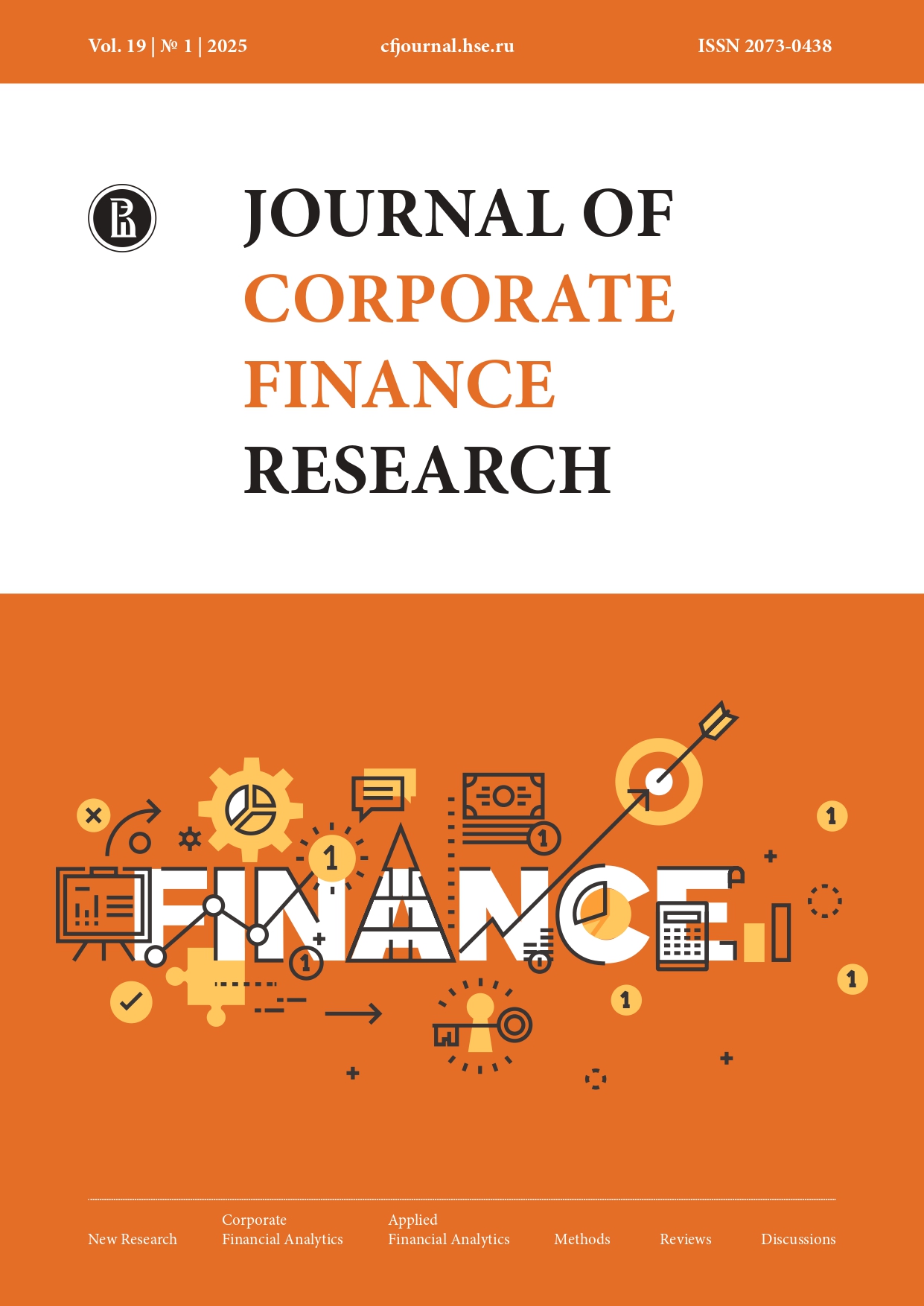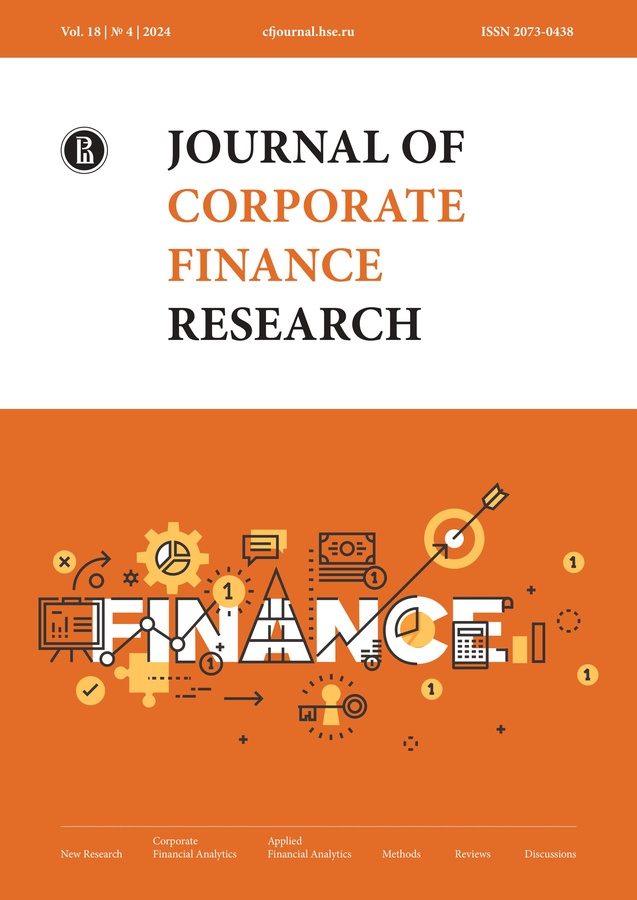Многофакторная трендовая модель устойчивого роста предприятия в условиях конкуренции и инфляции
- Авторы: Белых В.1
-
Учреждения:
- Новосибирский государственный университет экономики и управления «НИНХ», Новосибирск, Россия
- Выпуск: Том 18, № 4 (2024)
- Страницы: 111-124
- Раздел: Новые исследования
- URL: https://journal-vniispk.ru/2073-0438/article/view/302676
- DOI: https://doi.org/10.17323/j.jcfr.2073-0438.18.4.2024.111-124
- ID: 302676
Цитировать
Полный текст
Аннотация
Данное исследование посвящено анализу роста предприятий в условиях конкуренции и инфляции, с акцентом на концепцию устойчивого роста. Существующие модели устойчивого роста больше подходят для решения обратной задачи, где определяются источники финансирования при заданном темпе роста, и менее эффективны для решения прямой задачи — планирования объёмов продаж при известных исходных данных. Это связано с тем, что традиционные модели не учитывают внешние факторы роста. Хотя инфляционные модели устойчивого роста улучшили ситуацию, они по-прежнему не принимают во внимание конкуренцию. Предлагаемая многофакторная трендовая модель устойчивого роста заполняет этот пробел, учитывая ключевые драйверы роста: коэффициент инвестирования, оборачиваемость активов, рентабельность продаж, финансовый рычаг и динамику цен на продукцию и ресурсы. Модель разработана с использованием методов дифференциального и интегрального исчисления, при этом финансовые коэффициенты рассматриваются как динамичные величины, описываемые трендами, отражающими влияние внешней среды. Потенциал модели продемонстрирован на примере различных отраслей. Модель позволяет моделировать весь жизненный цикл предприятия, включая период спада, и может служить инструментом стратегического планирования. Она описывает естественный, типичный и логистический рост, и может быть использована на ранних стадиях жизненного цикла, когда данные ограничены.
Об авторах
В. Белых
Новосибирский государственный университет экономики и управления «НИНХ», Новосибирск, Россия
Автор, ответственный за переписку.
Email: v.v.belykh@gmail.com
Список литературы
- Gentry J.A. (1988). State of the Art of Short-Run Financial Management // Financial Management, 41–57. DOI: https://doi.org/10.2307/3665525
- Рябова Е.В., Cамоделкина М.А. (2018). Факторы устойчивого роста российских компаний // Финансы: теория и практика. Том. 22. №1. С. 104–117. https://doi.org/10.26794/2587-5671-2018-22-1-104-117 = Rjabova E.V., Samodelkina M.A. (2018). Factors of sustainable growth of Russian companies // Finance: theory and practice, 22(1), 104–117. (In Russ.) https://doi.org/10.26794/2587-5671-2018-22-1-104-117 DOI: https://doi.org/10.26794/2587-5671-2018-22-1-104-117
- Ocak M., Fındık D. (2019). The impact of intangible assets and sub-components of intangible assets on sustainable growth and firm value: evidence from Turkish listed firms // Sustainability, 11(19), 5359. https://doi.org/10.3390/su11195359 DOI: https://doi.org/10.3390/su11195359
- Oprean-Stan C., Oncioiu I., Iuga I.C., Stan S. (2020). Impact of Sustainability Reporting and Inadequate Management of ESG Factors on Corporate Performance and Sustainable Growth // Sustainability, 12(20), 8536. https://doi.org/10.3390/su12208536 DOI: https://doi.org/10.3390/su12208536
- Ionita C., Dinu E. (2021). The effect of intangible assets on sustainable growth and firm value–Evidence on intellectual capital investment in companies listed on Bucharest Stock Exchange // Kybernetes, 50(10), 2823–2849. https://doi.org/10.1108/K-05-2020-0325 DOI: https://doi.org/10.1108/K-05-2020-0325
- Teng X., Wang Y., Wang A., Chang B.-G., Wu K.-S. (2021). Environmental, Social, Governance Risk and Corporate Sustainable Growth Nexus: Quantile Regression Approach // International Journal of Environmental Research and Public Health, 18(20), 10865. https://doi.org/10.3390/ijerph182010865 DOI: https://doi.org/10.3390/ijerph182010865
- Chen X., Liu C., Liu F., Fang V. (2021). Firm Sustainable Growth during the COVID-19 Pandemic: The Role of Customer Concentration // Emerging Markets Finance and Trade, 57(6), 1566–1577. https://doi.org/10.1080/1540496X.2021.1904884 DOI: https://doi.org/10.1080/1540496X.2021.1904884
- Ain Q.U., Yuan X., Javaid H.M., Naeem M. (2022). Board gender diversity and sustainable growth rate: Chinese evidence // Economic Research-Ekonomska Istraživanja, 35(1), 1364–1384. doi: 10.1080/1331677X.2021.1965002 DOI: https://doi.org/10.1080/1331677X.2021.1965002
- Steblyanskaya A.N., Ai Mingye, Efimova O.V., Kleiner G.B., Rybachuk M.A. (2022). Multi-capital approach for sustainable growth: experience from the oil & gas companies // Finance: Theory and Practice. 26(4), 29–43. https://doi.org/10.26794/2587-5671-2022-26-4-29-43 DOI: https://doi.org/10.26794/2587-5671-2022-26-4-29-43
- Wang L., Tian Z., Wang X., Peng N. (2023). C.E.O. academic experience and firm sustainable growth // Economic Research-Ekonomska Istraživanja, 36(2), 2135553. https://doi.org/10.1080/1331677X.2022.2135553 DOI: https://doi.org/10.1080/1331677X.2022.2135553
- Kisor M. (1964). The Financial Aspects of Growth // Financial Analysts Journal, 20(2), 46–51. DOI: https://doi.org/10.2469/faj.v20.n2.46
- Lerner E., Carleton W. A (1966). Theory of Financial Analysis. New York: Harcourt, Brace and World.
- Higgins R.C. (1977). How much growth can a firm afford? // Financial Management, 6(3), 7–16. DOI: https://doi.org/10.2307/3665251
- Ulrich T., Arlow P. (1980). The Financial Implications of Growth // Journal of Small Business Management, 18(4), 28–33.
- Johnson D. (1981). The Behavior of Financial Structure and Sustainable Growth in an Inflationary Environment // Financial Management, 10(4), 30–35. https://doi.org/10.2307/3665216 DOI: https://doi.org/10.2307/3665216
- Eisemann P. (1984). Another Look at Sustainable Growth // Journal of Commercial Bank Lending, 67(2), 47–51.
- Lewellen W., Kracaw W. (1987). Inflation, Corporate Growth, and Corporate Leverage // Financial Management, 16(4), 29–36. https://doi.org/10.2307/3666106 DOI: https://doi.org/10.2307/3666106
- Gulati D., Zantout Z. (1997). Inflation, capital structure, and immunization of the firm’s growth potential // Journal of Financial and Strategic Decisions, 10(1), 77–90.
- Nissim D., Penman S.H. (2001). Ratio analysis and equity valuation: From research to practice // Review of accounting studies, (6), 109–154. https://doi.org/10.1023/A:1011338221623 DOI: https://doi.org/10.1023/A:1011338221623
- Soliman M.T. (2004). Using IndustryAdjusted DuPont Analysis to Predict Future Profitability. Working paper, Stanford University. DOI: https://doi.org/10.2139/ssrn.456700
- Mauboussin M., Johnson P. (1997). Competitive advantage period: the neglected value driver // Financial Management, 26(2), 67–74. https://doi.org/10.2307/3666168 DOI: https://doi.org/10.2307/3666168
- Березинец И.В., Удовиченко О.М., Девкин А.А. (2016). Прогнозирование рентабельности российских компаний с использованием отраслевой модели Дюпон // Российский журнал менеджмента. Т. 14. №1. С. 3–28. = Berezinets, I.V., Udovichenko, O.M., Devkin, A.A. (2016). Prediction of Profitability of Russian Companies: The Industry-Adjusted DuPont Model // Russian Management Journal, 14(1), 3–28. (In Russ.). DOI: https://doi.org/10.21638/spbu18.2016.101
- Allen R.G.D. (1960). Mathematical Economics. London: Macmillan, 812 p.
- Harrod R.F. (1939). An essay in dynamic theory // The economic journal, 49(193), 14–33. DOI: https://doi.org/10.2307/2225181
- Domar E.D. (1946). Capital expansion, rate of growth, and employment // Econometrica, Journal of the Econometric Society, 14(2), 137–147. DOI: https://doi.org/10.2307/1905364
- Чачин П. (2011). 20 лет сотовой связи в России // itWeek. URL:https:// www.itweek.ru/mobile/article/detail.php?ID=133937 (дата обращения 12.12.2024). = Chachin P. (2011). 20 years of cellular communications in Russia // itWeek. URL:https:// www.itweek.ru/mobile/article/detail.php?ID=133937 (date of access 12.12.2024). (In Russ.).
- Юданов А. (2007). «Быстрые» фирмы и эволюция российской экономики // Вопросы экономики. №2. С. 85–100. = Yudanov A. (2007). «Fast» firms and the evolution of the Russian economy // Economic Issues, (2):85–100. (In Russ.). DOI: https://doi.org/10.32609/0042-8736-2007-2-85-100
- Verhulst P.F. (1838). Notice sur la loi que la population suit dans son accroissement // Correspondence mathematique et physique, (10), 113–129.
- Pearl R., Reed L.J. (1920). On the rate of growth of the population of the United States since 1790 and its mathematical representation // Proceedings of the national academy of sciences, 6(6), 275–288. DOI: https://doi.org/10.1073/pnas.6.6.275
- Mansfield E. (1961). Technical change and the rate of imitation // Econometrica: Journal of the Econometric Society, 29(14), 741–766. DOI: https://doi.org/10.2307/1911817
- Bass F.M. (1969). A new product growth for model consumer durables // Management science, 15(5), 215–227. DOI: https://doi.org/10.1287/mnsc.15.5.215
- Rao S.K. (1985). An empirical comparison of sales forecasting models // Journal of Product Innovation Management, (4), 232–242. DOI: https://doi.org/10.1111/1540-5885.240232
- Grübler A., Nakićenović N. (1991). Long waves, technology diffusion, and substitution // Laxenburg: IIASA, 313–343.
- Miller D., Friesen P.H. (1984). A longitudinal study of the corporate life cycle // Management science, 30(10), 1161–1183. https://doi.org/10.1287/mnsc.30.10.1161 DOI: https://doi.org/10.1287/mnsc.30.10.1161
- Anthony J.H., Ramesh K. (1992). Association between accounting performance measures and stock prices // Journal of Accounting and Economics, (15), 203–227. https://doi.org/10.1016/0165-4101(92)90018-W DOI: https://doi.org/10.1016/0165-4101(92)90018-W
- Jenkins D.S., Kane G.D., Velury U. (2004). The impact of the corporate life‐cycle on the value‐relevance of disaggregated earnings components // Review of Accounting and Finance, 3(4), 5–20. https://doi.org/10.1108/eb043411 DOI: https://doi.org/10.1108/eb043411
- Dickinson V. (2011). Cash flow patterns as a proxy for firm life cycle // The Accounting Review, 86(6), 1969–1994. https://doi.org/10.2308/accr-10130 DOI: https://doi.org/10.2308/accr-10130
Дополнительные файлы











